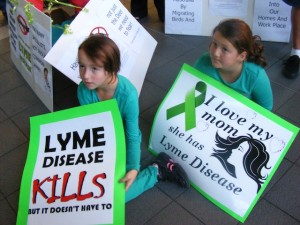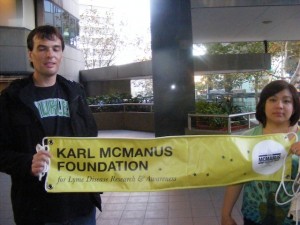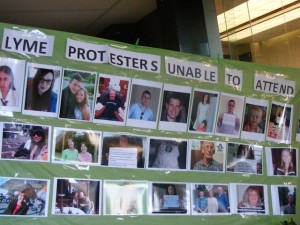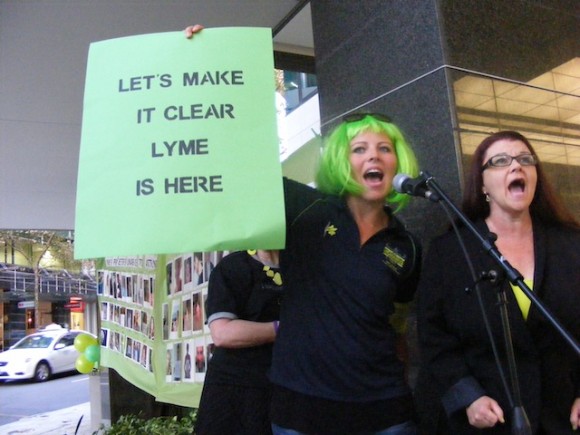A young woman in a wheelchair slumps over and loses consciousness as people rush to her aid. She is taking part in a half -dozen Lyme awareness events around the country.
Mandy Shuker is a Lyme disease sufferer and her condition and the reason she was at the event were never more evident. After some minutes she was revived and rejoined the protest.
Organised by Lyme disease advocates Karen Smith and Janice Foster, these events including the Sydney protest held outside the offices of NSW Health in North Sydney on May 10, coincided with many similar events in a wordwide display of solidarity for Lyme sufferers.
Smith, also a Lyme disease sufferer, said Mandy had an episode because of the disease.
“The doctors still aren’t recognising that it’s there, so we’re trying to acknowledge and thank Professor Baggoley [Professor Chris Baggoley Chief Medical Officer for the Australian Government] for looking into it but that could take to next year,” she said.
“In the meantime, we have patients that aren’t being treated and doctors that aren’t acknowledging the disease and telling patients to leave their offices.”
That’s why the small but vocal group gathered outside NSW Health, fed up with being misdiagnosed and told that Lyme disease is not present in Australia leading them to seek diagnosis and treatment overseas.
“We really just want NSW Health to recognise that if a patient comes in with a positive result from overseas they will be able to get treatment and not be told that Lyme disease isn’t present in Australia,” Smith said.
The position of NSW Health on Lyme disease is a little cloudy. Its website states that although locally-acquired Lyme Borreliosis cannot be ruled out, there is little evidence that it occurs in Australia. It points out that only some species of ticks are capable of being infected by the Borrelium bacteria and only these infected ticks can pass the infection on to humans. This group of ticks is found in Asia, Europe, and North America but not in Australia, it explains.
 But there is an acknowledgement of a continuing risk of overseas-acquired Lyme being imported into NSW.
But there is an acknowledgement of a continuing risk of overseas-acquired Lyme being imported into NSW.
Many people have been diagnosed as having the disease. Betty (last name withheld) has been suffering from the disease since 2008 and describes it as a very debilitating disease that carries a stigma with it.
“It’s a terrible disease. It affects you in many different ways from stigmas of isolation and ignorance of people not knowing what the disease is about to the actual physical problems associated with the disease,” she said.
Betty has never been overseas and believes she contracted the disease in 2008. She was diagnosed in 2011. She finds it difficult to fathom NSW Health’s stance that there is no evidence the disease exists here and said that view created difficulties for sufferers.
“I’m unable to seek treatment here, get proper testing here, or any type of support here,” she said.
Lyme disease is caused by the bacterium called Borrelia and is transmitted from the bite of a tick that is infected with the Borrelia bacterium. Initial symptoms can include a rash, fever and headaches, tiredness and joint pain. If untreated later stages of the disease can be life threatening as it can cause infection of the brain and surrounding membranes and infection in and around the heart.
Mualla McManus spoke at the event. Her husband Karl died from health issues related to Lyme disease in July 2010, motivating Mualla to set up the Karl McManus Foundation.
“The foundation is doing everything it can to get scientific evidence to prove that Australia has its own unique Borrelia species,” she said.
 “It will be impossible for NSW Health to deny the presence of Lyme disease in Australia once we’ve got the evidence.”
“It will be impossible for NSW Health to deny the presence of Lyme disease in Australia once we’ve got the evidence.”
A recent conference organised by a Lyme advocacy group attracted more health professionals than organisers had expected, with 33 GPs attending from around the country. According to an ABC Radio National feature, doctors in the country risk their professional reputations by diagnosing patients with Lyme because many in the medical community do not accept that the disease is present in Australia.
But there has been a growing demand from GPs, leading Canberra-based infectious diseases clinician Professor Peter Collingen to express his concern that the over-use of antibiotics in treating what was thought to be Lyme disease was doing more harm than good.
“Some people want an antibiotic called Ceftriaxone, for instance, which is one of our critically important or last-line antibiotics, and they want to take that for a year or more. I think the evidence for doing so is pretty flimsy,” the professor said in a recent ABC Radio National report.
Brad Mendiatta, who has been suffering with the disease for 13 years, said he didn’t agree.
“I got bitten in 2000. I remember the bite and within six months I started developing neurological vision symptoms, hearing symptoms, progressively twitching, chronic fatigue, anxiety, depression and bowel and urine intolerance. They’ve gone now since I started treatment,” Mendiatta said.
He said he went undiagnosed for several years and approached several doctors including neurologists, infectious disease specialists and immunologists before finally being diagnosed by a doctor in Laurieton on the NSWnorth coast. He is now being treated by USA naturopathic doctor Nicola McFadzean and his prognosis is good.
“She’s a Lyme-literate doctor that treats me via Skype and face-to-face consults a couple of times a year. She’s into natural [medicine] combined with antibiotics, supplements and lifestyle [changes]. That’s what you really need to do to get over this,” he said.
These advocates, patients and sufferers are having their voices heard with the federal government’s chief medical officer, Professor Baggoley, convening a clinical advisory committee to look into Lyme disease. The committee had its first meeting in March this year.
“There are a lot of distressed people; it’s a matter of controversy and it’s a matter where people are having very strongly held views and they are polarised,” the professor said in a recent interview on the ABC’s Radio National.
“Where there is controversy and where I can get people together to look at and consider evidence and even ask questions of what else might need to be done to help settle this, that would be a useful thing to do so I’m doing it.”
Not before time according to Danielle Ryan.
“I’ve been suffering form symptoms for 12 years and they vary,” she said.
“I was bitten and developed a bulls-eye rash in Mona Vale. I’m a textbook case Lyme disease patient – I had flu-like symptoms, couldn’t move couldn’t swallow. By that time I had developed more rashes that had spread up my body. I was diagnosed with a virus and sent home to go to bed.”
According to the USA national public health institute, US Centers for Disease Control and Prevention (CDC) website, a sign of Lyme disease can be a red expanding rash called erythema migrans (EM) more commonly referred to as “bull’s-eye rash”. The rash occurs in about 70 per cent of infected people and begins at the site of the tick bite after a delay of 3-30 days. The rash gradually expands over a period of several days and can reach up to 30cm across. Parts of the rash may clear as it enlarges, resulting in a Bull’s-eye appearance.
“I’ve been diagnosed in three different countries by four different specialists. I’ve travelled to the UK to a clinic there; I’ve spoken to a specialist in the US and I have seen two doctors here who are specialists in Lyme disease. They have all diagnosed me with blood tests and clinical diagnosis,” said Ryan.
 The CDC recommends a two-pronged attack when testing blood for evidence of antibodies against the Lyme disease bacteria.
The CDC recommends a two-pronged attack when testing blood for evidence of antibodies against the Lyme disease bacteria.
The first step uses a testing procedure called “EIA” (enzyme immuno assay) or, more rarely, an “IFA” (indirect immunofluorescence assay). If this first step is negative, no further testing of the specimen is recommended; if positive or indeterminate (“equivocal”), the second step should be performed.
The second step uses a test called an immunoblot test, commonly known as a “Western blot” test. Results are considered positive only if the EIA/IFA and the immunoblot are both positive.
The two steps of Lyme disease testing need to be done together. CDC does not recommend skipping the first test and just doing the Western blot as doing so could increase the frequency of false positive results and lead to misdiagnosis and improper treatment.
As far as Lyme disease sufferers are concerned there is underwhelming support for them in the Australian medical community. They protested simply to urge for recognition of their symptoms.
- The CDC website recommends that if you find a tick attached to your skin, there’s no need to panic. Ordinary fine-tipped tweezers will remove a tick quite effectively.
- Use fine-tipped tweezers to grasp the tick as close to the skin’s surface as possible.
- Pull upward with steady, even pressure.
- Don’t twist or jerk the tick; this can cause the mouth-parts to break off and remain in the skin.
- If this happens, remove the mouth-parts with tweezers.
- If unable to remove the mouth easily with clean tweezers, leave it alone and let the skin heal.
- After removing the tick, thoroughly clean the bite area and your hands with alcohol, an iodine scrub or soap and water.
- Avoid folklore remedies such as “painting” the tick with nail polish or petroleum jelly, or using heat to make the tick detach from the skin.
- Your goal is to remove the tick as quickly as possible–not waiting for it to detach.


